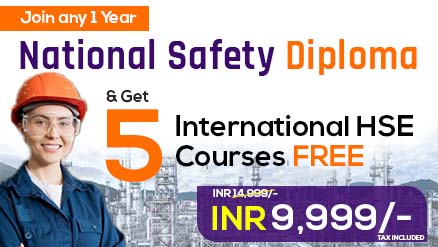
National Diploma Course - INDIA
This Advanced Diploma program is a qualification for aspiring health and safety professionals which has been designed to provide students with the expertise required to undertake a career as a safety and health practitioner and also provides a sound basis for progression to postgraduate study in the similar field or other competent industries. In recognition of the importance of this crucial business area, we have worked with experienced practitioners in designing this programme. This expertise, along with informed academic knowledge, provides a course which teaches the skills and knowledge for the practical application of Strategic Health, Safety and Risk Management essential in the professional environment today. The course would also be of interest to managers who wish to attain a formal management qualification in this area and others who wish to have onward career development in this field.
This course provide students with the necessary means to develop the capacity to carry out independent scientific and technical research and assessments on environmental issues. In addition, students will learn to analyse and assess environmental systems and problems; be able to propose sustainable solutions to environmental problems; and contribute to the development of policies and strategies for environmental planning. This Masters Diploma programme enhances you to understand natural systems processes in a sustainable way and apply this knowledge in your day-to-day work. The aims of the programme are:
- To develop the students research and analytical skills
- To develop a wider and more in-depth understanding of occupational health, safety, environment and Risk Management theory and practice.
- The course is designed to meet the needs of existing or aspiring Managers and leaders in health or allied organizations
1st Year
- International management of health and safety 1.1. Principles of health and safety management 1.2. Loss causation and incident investigation 1.3. Measuring and reviewing health and safety performance 1.4. Identifying hazards, assessing and evaluating risks 1.5. Risk Control 1.6. Organisational factors 1.7. Human factors 1.8. Regulating health and safety
- International control of hazardous agents in the workplace 2.1. Principles of chemical control, toxicology and epidemiology 2.2. Hazardous substances and other chemicals – assessment of risk 2.3. Hazardous chemicals – engineering controls and personal protective 2.4. equipment 2.5. Monitoring and measuring 2.6. Biological agents 2.7. Physical agents 1 – noise and vibration 2.8. Physical agents 2 – radiation 2.9. Psycho-social agents 2.10. Musculoskeletal risks and controls 2.11. Work environment risks and controls 2.12. Managing occupational health
- Safety Management and Communication 3.1. Discover the Proven Safety Communication Framework 3.2. Capture Your Audience Attention 3.3. Achieve Memorable Safety Communication 3.4. Getting the Effective Communication System 3.5. Transform your Safety Communication 3.6. How to make your safety writing Engaging
- International workplace and work equipment safety 4.1. General workplace issues 4.2. Principles of fire and explosion 4.3. Workplace fire risk assessment 4.4. Storage, handling and processing of dangerous substances 4.5. Work equipment (general) 4.6. Work equipment (workplace machinery) 4.7. Work equipment (mobile, lifting and access) 4.8. Electrical safety 4.9. Construction hazards and controls 4.10.Workplace transport and driving for work 4.11.Pressure system hazards and controls
- Risk Management and Control 5.1. Risk Assessment and Safety Management 5.2. Human Factors Methods 5.3. Value & Risk Management 5.4. Project Management Theory and Practice 5.5. Human Factors in the Design and Evaluation of Control Rooms 5.6. Fire Safety, Explosions and Process Safety 5.7. Environmental Impact Assessment 5.8. Learning from Disasters
- Fundamentals of Health and Safety Engineering 6.1. The Importance of Safety and Health for Engineers 6.2. Safety and Health Professions 6.3. Fundamental Concepts and terms 6.4. Federal agencies, Laws and regulations 6.5. Other laws Regulation, Standards and Codes
2nd Year
- Environmental Planning and Management 1.1. Introduction to Environmental Planning and Management 1.2. Sustainable Manufacturing 1.3. Environmentally Conscious manufacturing 1.4. The IOS 14000 Model 1.5. Life Cycle Assessment 1.6. Manufacturing Strategies: Agile, Lean and Flow Manufacturing 1.7. Environmental Risk Assessment and management 1.8. Competing on Environmental Management 1.9. Environmental Science & Technology 1.10.Sustainability through Green Science and Technology 1.11.The Five Environmental Spheres. 1.12.Green Chemistry, Biology and Biochemistry 1.13.Water: A Unique substance Essential for Life. 1.14.Aquatic biology, Microbiology and Chemistry 1.15.Keeping Water Green 1.16.The Atmosphere: A Protective Blanket around Us 1.17.Environmental Chemistry of the Atmosphere
- Environmental Technology for Sustainable Development 2.1. Sustaining an Atmosphere for life on Earth 2.2. Green Science and Technology to alleviate global warming 2.3. Geospheres hazards and Sustaining a green Geosphere. 2.4. The Biosphere: Ecosystems and Biological Communities 2.5. Toxic Effects on organisms and Toxicological Chemistry 2.6. Industrial Ecology for sustainable resources Utilization 2.7. Sustainable Energy: Key to Sustainability
- Environmental Technology and Engineering 3.1. Biosensors for Life Sciences 3.2. Ecological, Economic and Marketing Aspects of the Application of Bio-fertilizers in the Production of Organic Food 3.3. Environmental Problems Induced by Pollutants in Air, Soil and Water Resources 3.4. Emission Sources and Their Contributions to Ambient Air Concentrations of Pollutants 3.5. Qualitative Environmental Health Impact Assessment 3.6. The Role of Adaptive Environmental Management in Sustainable Development Case Study Assessing the Economical Benefits of Sustainable Construction 3.7. Indoor Air Pollution 3.8. Soil Pollution and Remediation Problems 3.9. Distribution of Trace and Major Elements in Lignite and Products of Its Combustion-Leaching Experiments and Cluster Analysis 3.10.Air Radioactivity Monitoring 3.11.The Application of Membrane Separation Processes as Environmental Friendly Methods in the Beet Sugar Production 3.12.Assessment of Air Quality 3.13.Habitation and Noise
- Practical approach of international Health, Safety, Environment and the Risk Management Approximately 10,000 words in length


Examination
- MDT-1 International management of health and safety (100 Marks)
- MDT-2 International control of hazardous agents in the workplace (100 Marks)
- MDT-3 International workplace and work equipment safety (100 Marks)
- MDT-4 Safety Management and Communication (100 Marks)
- MDT-5 Risk Management and Control (100 Marks)
- MDT-6Fundamentals of Health and Safety Engineering (100 Marks)
- MDT-7Environmental Planning and Management (100 Marks)
- MDT-8 Environmental Science & Technology (100 Marks)
- MDT-9 Environmental Technology for Sustainable Development (100 Marks)
- MDT-10Environmental Technology and Engineering (100 Marks)
- MDP-11 MDP- Practical approach of international Health, Safety, Environment and the Risk Management (200 Marks)
- Candidates/ Delegates who successfully complete and obtain the National Diploma Course (approved by the Govt. of India) could further apply for a membership status with IIRSM. Awarding of the membership is at the discretion of IIRSM provided they have met the required guidelines for the same.
- Successful candidate will get Certificate & Mark list issued from Central Board of Examination & National Development agency, Promoted by Govt. of India
- Recognized in most countries
- Certification considered one year count increment in your educational qualification












